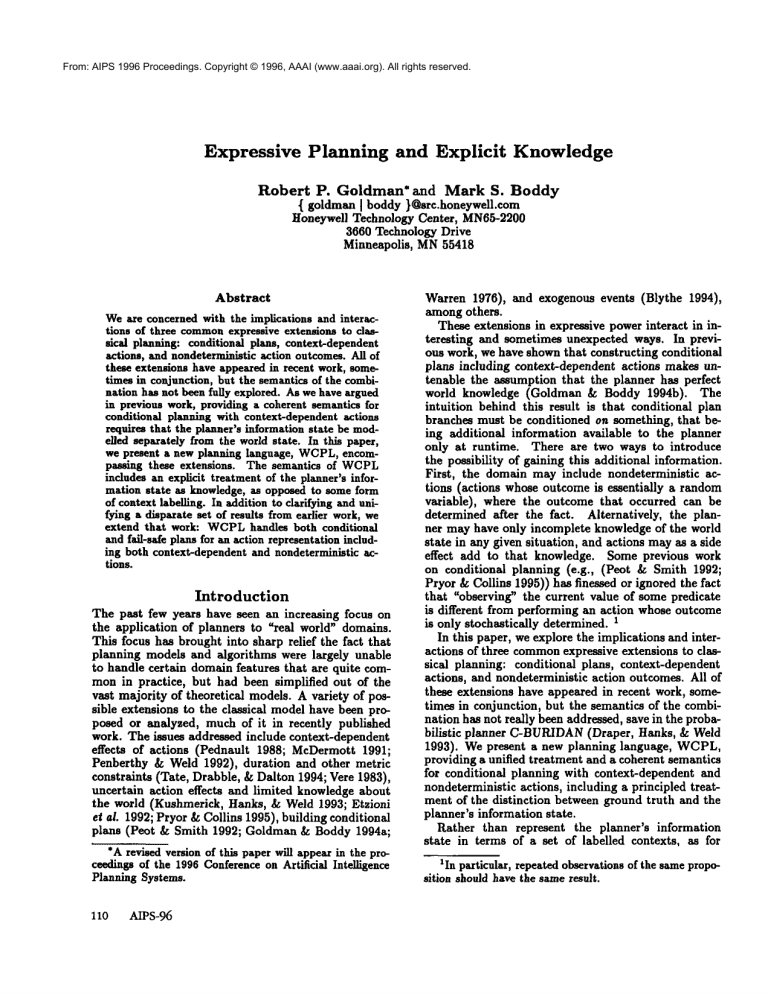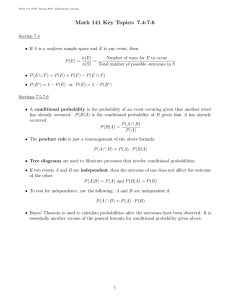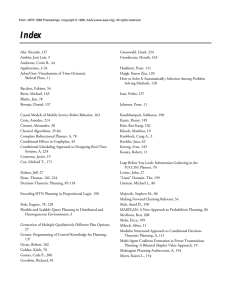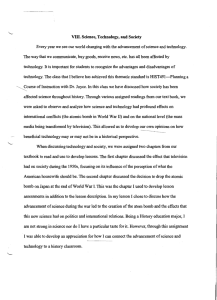
From: AIPS 1996 Proceedings. Copyright © 1996, AAAI (www.aaai.org). All rights reserved.
Expressive
Planning
and Explicit
Knowledge
Robert
P. Goldman*
and Mark S. Boddy
{ goldman [ boddy }@src.honeywell.com
Honeywell Technology Center, MN65-2200
3660 Technology Drive
Minneapolis, MN55418
Abstract
Weare concerned with the implications and interactions of three common
expressive extensions to classical planning: conditional plans, context-dependent
actions, and nondeterministic action outcomes.All of
these extensions have appeared in recent work, sometimes in conjunction, but the semantics of the combination has not been fully explored. As we have argued
in previous work, providing a coherent semantics for
conditional planning with context-dependent actions
requires that the planner’s information state be modelled separately from the world state. In this paper,
we present a new planning language, WCPL,encompassing these extensions. The semantics of WCPL
includes an explicit treatment of the planner’s information state as knowledge, as opposed to some form
of context labelling. In addition to clarifying and unifying a disparate set of results from earlier work, we
extend that work: WCPLhandles both conditional
and fail-safe plans for an action representation including both context-dependent and nondeterministic actions.
Introduction
The past few years have seen an increasing focus on
the application of planners to "real world" domains.
This focus has brought into sharp relief the fact that
planning models and algorithms were largely unable
to handle certain domain features that are quite commonin practice, but had been simplified out of the
vast majority of theoretical models. A variety of possible extensions to the classical model have been proposed or analyzed, much of it in recently published
work. The issues addressed include context-dependent
effects of actions (Pednault 1988; McDermott 1991;
Penberthy & Weld 1992), duration and other metric
constraints (Tate, Drabble, &Dalton 1994; Vere 1983),
uncertain action effects and limited knowledge about
the world (Kushmerick, Hanks, & Weld 1993; Etzioni
et al. 1992; Pryor &Collins 1995), building conditional
plans (Peot & Smith 1992; Goldman & Boddy 1994a;
*Arevised version of this paper will appear in the proceedings of the 1996Conferenceon Artificial Intelligence
Planning Systems.
110 AIP$-96
Warren 1976), and exogenous events (Blythe 1994),
among others.
These extensions in expressive power interact in interesting and sometimes unexpected ways. In previous work, we have shownthat constructing conditional
plans including context-dependent actions makes untenable the assumption that the planner has perfect
world knowledge (Goldman & Boddy 1994b). The
intuition behind this result is that conditional plan
branches must be conditioned on something, that being additional information available to the planner
only at runtime. There are two ways to introduce
the possibility of gaining this additional information.
First, the domain may include nondeterministic actions (actions whose outcome is essentially a random
variable), where the outcome that occurred can be
determined after the fact. Alternatively, the planner may have only incomplete knowledge of the world
state in any given situation, and actions mayas a side
effect add to that knowledge. Some previous work
on conditional planning (e.g., (Peot & Smith 1992;
Pryor & Collins 1995)) has finessed or ignored the fact
that "observing" the current value of some predicate
is different from performing an action whose outcome
is only stochastically determined. 1
In this paper, we explore the implications and interactions of three commonexpressive extensions to classical planning: conditional plans, context-dependent
actions, and nondeterministic action outcomes. All of
these extensions have appeared in recent work, sometimes in conjunction, but the semantics of the combination has not really been addressed, save in the probabilistic
planner C-BURIDAN
(Draper, Hanks, & Weld
1993). Wepresent a new planning language, WCPL,
providing a unified treatment and a coherent semantics
for conditional planning with context-dependent and
nondeterministic actions, including a principled treatment of the distinction between ground truth and the
planner’s information state.
rtather than represent the planner’s information
state in terms of a set of labelled contexts, as for
1In particular, repeated observations of the sameproposition should have the sameresult.
From: AIPS 1996 Proceedings. Copyright © 1996, AAAI (www.aaai.org). All rights reserved.
example in (Peot & Smith 1992; Draper, Hanks,
Weld 1993), we provide an explicit semantics for the
planner’s knowledge as a modal operator over possible states of the world. Modelling the planner’s information state in this way enables us to handle both
information-gathering in conditional plans, and conformant or "fall-safe" plans, in which it can be shown by
reasoning over possible outcomes, despite incomplete
information, that the plan will achieve the specified
goal(s). In fact, we can integrate these approaches
a way that the labelling approaches cannot: reasoning
by cases can modify the planner’s information state at
runtime, which can then lead to conditional branching
in the plan where there may have been no explicitly
labelled "context" or "outcome."
This flexibility
allows us to handle both versions
of Moore’s "bomb in the toilet" problem (McDermott
1987). The "bomb in the toilet" actually covers two
substantially different problems. In the first version,
the planner is confronted with two packages, one of
which contains a bomb. There is no way to distinguish
the explosive package from its harmless counterpart.
There is also a toilet, immersion in which will render
the bombineffectual. In this case, there is a simple
and intuitive plan for ensuring that there will not be
an explosion: immerse both packages. In the second
version of the bombin the toilet, only one package will
fit in the toilet, but the planner has available a bombdetecting action that will identify which package needs
to be immersed to prevent an explosion. In this case a
conditional plan is needed: find out where the bombis,
then immerse the appropriate package. Handling both
of these problems requires a planning system to be able
both to reason by cases, and to construct conditional
plans based on the acquisition of new information.
In the rest of this paper, we present the syntax
and semantics of WCPL’saction representation ("Actions"), add a modality corresponding to the planner’s knowledge of the current world state and define
information-gathering actions ("Knowledge"), and add
conditional branches to the planning language ("Conditionai plans"). Wethen provide a detailed solution to
the two versions of the bombin the toilet problem. Finally, we discuss some related work, draw conclusions
and describe some directions for further research.
For more convenient reference, we have moved all
of the definitions and propositions to the end of the
paper.
Actions
Previous work in this area, both ours and others’, has
used notations derived from STRIPS and ADL(Pednault 1988). In this paper, we find it more convenient to employ propositional dynamic logic (PDL).
PDLprovides us with previously existing constructs
for nondeterminism and conditionals. Our discussion
of PDLfollows Rosenschein’s (1981). To maintain the
relation between this work and previous work as clearly
as possible, we relate the PDLnotation to STRIPSor
ADL-style equivalents where possible.
Syntax
In propositional dynamic logic, we speak of programs
made of actions and propositional wffs that describe
world states. Weuse the term "programs," rather than
plans, both to conform to PDL usage and to avoid
confusion when we provide the PDLcorresponding to
a plan language like STRIPS. Given a set of atomic
propositions, ~, and a set of atomic actions, ~t, we
define the wffs, 7~, and programs, ,4, over ¯ and b~ as
follows:
1. if cr E b~, then c~ E .A
~
2. if~E@,then~E7
3. ifP, Q E 7), then -,P, PVQE’P
4. ffPE7 ~, andAE~4, then (A)PET~
5. cE~
6. if P E 7~ and P contains no sub-formula of the form
(A) P, then P? E .4.
7. IfA, B E.4, then A;B E~4
8. If A, B E .A, then A U B E .A
is the null action. Weprovide the conventional extensions of notation, e.g. A for conjunction, as syntactic sugar. Wealso provide a dual for the 0 modality,
[1 (see discussion of semantics, below). A literal is
atomic proposition or its negation--if ~ E @, then ~b
and "-~ are literals.
PDLalso employs Kleene star for (indefinite) repetition of actions. However, we do not use Kleene star
in WCPL,
so we have left it out of the discussion here.
Semantics
The semantics of PDLis defined in terms of structures, S, written (W, 9, rn). Wis non-empty set of
world states, lr is an interpretation of @, mappingeach
proposition to those states in Win which that proposition is satisfied. ~r is extended to compound
wife in the
standard way. m is an interpretation of the singleton
programs (those consisting of a single action), mapping
each action ~ to a set of pairs of world states denoting
permitted state transitions for a. The interpretation of
programsis defined recursively, based on the relations
in m (see Definition 1). ’?’ can be read as ’test,’ P?
limiting the possible subsequent world states to the
set of worlds where P holds. ’;’ denotes sequential
composition of programs and o denotes composition of
relations.
(A) P is satisfied in those worlds w for which there
exists another world w~ and a program A such that P is
satisfied in w’ and (w, w’) E re(A). Intuitively, P may
be true after A. There is a dual of 0, corresponding to
necessity D, where [A] P may be read as P necessarily
holds after A.
Goldman
111
From: AIPS 1996 Proceedings. Copyright © 1996, AAAI (www.aaai.org). All rights reserved.
Plans
in PDL
In this section, we discuss the PDLrepresentation for
plans, starting with the classical definition of an action, then expanding to actions with conditional and
context-dependent outcomes. A classical STRIPSoperator can be written as a set of preconditions, 7 and a
set of postconditions, ~, where both 7 and 6 are conjunctions of literals. In the classical definition, preconditions define not where the action will be successful, but where it can be applied. If the initial state is
such that one or more steps in a given plan will have
unsatisfied preconditions, the effects of that plan are
undefined.
For mathematical convenience, we want m to be a
complete relation. However, we also want to preserve
the distinction between well-formed and ill-formed
plans. In order to do this, we introduce a distinguished
atomic proposition planfail ~ ~.
Werequire m to have the property captured in Definition 2. mis restricted to state transitions (s, t)
which either the preconditions (7) is satisfied in s and
6 is satisfied in t, or in which7 is not satisfied in s and
planfail is satisfied in 4. If 7 is satisfied in s, the truth
value for both planfail and any proposition not mentioned in 6 must be the same in s and t. This definition
preserves the STRIPSassumption and records in the sequence of worlds whether or not the plan’s effects are
well-defined as described above. It also follows from
this definition that failure persists for any action, once
it becomestrue.
Planning is the process, given a description of an
initial state, and a goal, of finding a plan that will
achieve the goal whenexecuted in the initial state. In
the WCPLframework, the classical planning problem
is posed as follows: given a goal G and an initial state
description, D, find a program, A, such that:
D ~ [A]G
D --~ [A]--planfall
(1)
(2)
The first condition enforces that the plan achieve the
goal, the second that actions only be attempted when
their preconditions hold. This framework is slightly
more general than conventional classical planning in
that it permits planning with only partial knowledge
of the initial world state; the planner needs to know
only the relevant aspects of the initial state. In practice, this is a commonextension for classical planning
systems.
The next step is to extend the definition above to
context dependent actions. Westart with the same
representation as in Buridan (Kushmerick, Hanks,
Weld 1993), encoding context-dependent effects in
set of postconditions, each associated with one of a set
of mutually exclusive and exhaustive 4riggers.
In our revised action description, we encode triggers and the associated postconditions by replacing
the single conjunctive postcondition 6 with a set of
trigger/postcondition pairs, (~’(i), 5(i)) whereeach
112 AIPS-96
and 6(0 is a conjunction of iiterals. Werequire exhaustivity and mutual exclusion over the triggers ~’(i):
vi, j i # j =} ^
The semantics of a context-dependent action is then as
given in Definition 3 Wecan reason about the effects of
these actions using axiom schemas. For each action a
and proposition ~, let T+be the set of ~’(i) st ~ E 5(i)
and let T_ be the set of r(i) st -~ E 6(i), then we
axioms:
-
v ^,)
In other words, ~ necessarily holds following action A if
and only if either some trigger condition holds whose
effects include ~, or ~ is true immediately preceding
A and no trigger condition is satisfied whose effects
negate ~. In this framework, T+ is the causation precondi4ions for ~, and T_ is the causation preconditions
for-’~.
At thispointour frameworkhas the expressive
powerof Pednault’s
ADL,restricted
to a propositional
worlddescription.
Forplanning
systems
thatenforce
complete
knowledge
oftheinitial
state,
thisisno more
expressive than using STRIPS rules; triggers can be
treated as schema encoding multiple distinct sets of
preconditions for what should be distinct operators.
For a system allowing incomplete knowledge, the situation is different. Triggers which cannot be distinguished on the basis of what is knownabout the current state of the world introduce disjunction in the effects of actions. Limited quantification such as appears
in ucPoP (Penberthy & Weld 1992) can be viewed
encoding the same kind of disjunction in a different
notation.
This action definition is still not strong enoughto accommodate information-gathering
actions (Goldman
& Boddy 1994b), which requires a representation for
knowledge.
Wewould also like to be able to reason about
nondeterministic actions: actions whose outcomes are
in principle not predictable by our agent, such as
coin tosses. A commonand intuitive way of treating these nondeterrninistic actions has been as contextdependent actions whose triggers are unknownor unknowable.
For actions that can only be done once, or where
any subsequent repetition has an outcome dependent
on the first outcome, this is reasonable. Observations,
for example, have this property. The proposition to
be observed is unknown (but has some defined truth
value) before the observation. After the observation,
we know what that value is, and, in the absence of
any actions possibly changing that value, all subsequent observations must return the same result. For
actions that represent individual, independent events
such as coin flips, matters axe not so simple. Eachseparate instance of that action would have to have its
From: AIPS 1996 Proceedings. Copyright © 1996, AAAI (www.aaai.org). All rights reserved.
own unique, unknown "proposition,"
making the set
of propositions defining world states a function of the
current (partial) plan. Instead, we augment our action
definition, to allow each trigger to have not one outcome, but a set of mutually-exclusive and exhaustive
outcomes.
Weredefine actions in Definitions 4 and 5. Combining nondeterminism and context-dependence is notationally cumbersome. Therefore, we provide the definition in two steps. First, we define nondeterministic
outcomes in terms of a (nondeterministic) choice between primitive, deterministic actions (Definition 4).
Then, we apply this construction to the use of triggers
to provide context-dependence and provide the overall semantics (Definition 5). Intuitively, then, nondeterministic, context-dependent actions are equivalent
to a conditional statement, branching on the state of
the triggers, within which is nested a nondeterministic
choice.
Planning with nondetermistic actions in the absence
of any capability for explicit information-gathering requires the assumption that the outcomes of those actions are always observed by the planning agent when
they happen. This is the assumption made by Peot
and Smith’s CNLP and by our own PLINTH. In more
realistic domains, we must take into account that the
outcomes of context-dependent and nondeterministic
actions may not be known. This is the topic of the
next section.
Knowledge
In this section, we define the machinery necessary to
reason about information-gathering and the agent’s information state. Wedo this by defining an accessibility
relation and a conventional Kripke semantics (see Definition 6). The agent’s "knowledge~ is defined as the
set of propositions that hold in all knowledge-accessible
worlds: those accessible through ~. The details are
given in Definition 7. Intuitively, the agent’s beliefs are
founded on a correct understanding of the outcomes of
actions.
Let us consider how we are to represent the action
of observing some proposition, ~b E ¯ (obs(~)). There
may be some preconditions (e.g., the radio must be on
and the agent must be near it in order to observe the
weather). There will be two triggers for the action,
and -~. The postconditions for these triggers are
Know~and Know--~, respectively.
We escape the trap, commonto systems confusing
truth and knowledge, of needing to conclude that ~b was
true-and-known-to-be-true in the past, because ~ is a
trigger and Know~5the effect. The definition of the
accessibility relation ~ does not permit us to conclude
anything about the truth value of Know~before the
observation was made.
Observations mayalso occur as a side-effect of other
actions, where the outcome of the action may be observed by the executing agent. In that case, when coin-
posing the library of operators, one should indicate
those literals that becomeknown, as well as becoming
true. For example, on a well-regulated train system,
one knows when one has reached the destination.
An executing agent may also come to know a literal simply because that literal holds in all possible
outcomes of an action. An example of this kind of reasoning is conformant motion. If one moves towards an
obstacle a distance sufficient to cover all possible initial
positions, one can infer one’s position at the end of the
motion, even without any knowledge of the starting
point.
Conditional
plans
Previous conditional
planners, including CNLP,
Plinth, and C-Buridan, all make the branching actions
in their conditional plans implicit: in a given context,
do al. In a different context, do a2. The problem
of making those contexts correspond to appropriate
branch points and branching conditions is left to the
planning algorithm.
In PDL, we can introduce branching into our programs explicitly using a combination of ’?’ and ’O.’
That is, branching is defined in terms of testing and
non-deterministic choice. To take the example from
Peot and Smith’s paper, we might have a conditional
program of the form:
tJ
(knowroad clear?; drive to ski resort)
(knowroad not clear?;fly to ski resort)
U
([not knowroad clear ^ not knowroad not clear] ; fail)
These conditional tests do not correspond to any conventional notion of a "plan step." They are an explicit
part of a WCPL
plan for which there is no corresponding structure in any STRIPS-based planning language
we are aware of.
Like Rosenschein (1981), we restrict our programs
so that introducing choice points preserves termination. This is done by requiring the tests to be mutually
exclusive and exhaustive. Wediffer from Rosenschein
in the restriction we make on the propositions in the
tests. Werequire that the conditionals be of the form:
Know(~b)?; A
Know(-~)?; B
((--Know(~b) A -~Know(--~))?;
where A, B, C are programs whose conditionals are restricted as above. This formal restriction corresponds
to the fact that our conditionals all pertain to the
agent’s knowledge of its environment at plan execution time. Wecan make more complex conditionals by
nesting conditionals of the above form.
Wenow have the necessary tools to solve the "bomb
in the toilet" problem in both of its forms. Wepresent
our solutions in the following section.
Examples
In this section, we present WCPLplans for the two
versions of the bombproblem.
Goldman
113
From: AIPS 1996 Proceedings. Copyright © 1996, AAAI (www.aaai.org). All rights reserved.
In order to correctly represent dependencies in the
domainin the presence of uncertainty, it may be necessary to introduce dummyactions. 2 These dummyactions have alternative outcomes that exhaustively enumerate possible initial states with respect to some set
of propositions. For the bombproblems, we introduce
the following dummyaction:
Bomblocation- (BL)
preconditionsposteonditions.
trigger
outcomes
{in(bomb, pi~l),
T
"-in(bomb,pkg2)
{-in(bomb, pkgl),
in(bomb, pkg2))
which captures the constraint that the bombcan’t be
in two packages at once.
Wealso need two actions that involve putting packages in the toilet. Here is an action schema that describes these actions:
Flush(?pkg)
preconditions:
0
postcondltions:
trigger
outcome
in(bomb, ?pks) {in(?pkg, toilet),-armed(bomb)}
-in(bomb, ?pkg) {in(?pkg, toilet)}
This is sufficient to tackle the first version of
Moore’s problem, in which we are unable to observe the contents of the packages (and have no
need to, for that matter). The initial situation is:
{armed(bomb),--in(pkgl, toilet),--in(pkg2,
toilet)}.
The goal is {--armed(bomb)}. One solution to the
problem is the plan:
It is easy to see that the above plan is well-formed,
since none of the actions have preconditions. The plan
will also necessarily achieve its goal. In order to show
that this is the case, we need Proposition 1. Wemay
then prove the correctness of this plan, using the inference rule: [,4; B] P -= [A] [B] P, as follows:
[BL; lluah(pkgl ); tlush(pkg2)] -armed(bomb)?
[ BL; tlush(pkgl )] [ttush(pkg2)] -armed(bomb)
[BL;llusb(pkgJ)]-armed(bomb) Vin(pkg2, toilet)
[BL] [ffush(pIcgl)] -~armed(bomb)
V in(pkg2, toilet)
[BL] -,armed(bomb) V in(pkg2, bomb)v in(pkgl,
[BL]in(pkg2, bomb)vin(pkgl, bomb)
For the second version of the problem, we restrict
ourselves to a single-package toilet, refining our flush
operator as follows:
2These are generalizations of the dummystart action
used in conventional planners.
114 AIPS-96
Flush(?pkg)
preconditions:
postconditlons:
trigger
in(bomb, ?pkK)
{-full(toilet)
outcome
{in(?pkg,toilet), full(toilet),
-armed(bomb)}
{full(toilet ), in(?pkg,toilet)}
-in(bomb, ?pkg)
We require, in addition, an inspection axiom schema:
Inspect (?pkg) (I(?pkg))
preconditions:
0
postcondltlons:
trigger
outcome
in(bomb, ?pkg)
{Know(in(bomb, ?pkg))}
{Know(-~in(bomb,?pkg))}
-,in(bomb, ?pkg)
The initial conditions for the second problem are:
{
armed(bomb),-in(pkgl, toilet),
-ia(pkg2, toilet),-,full(toilet)
and the goal, as before, is {--armed(bomb)).
solution to this problem is the program:
BL; (I(pkgl));
(Know(in(bomb, pkgl))?; tlnsh(pkgl))
(Know(-~in(bomb, pkgl))?; tlush(pkg2))
( (-Know(in(bomb, pkgl))
--Know(-~in(bomb, pkgl)))?
The proof of correctness proceeds very much as for
the first problem, with the minor complications that
we must employ the fact that if the bombis not in
package 1, it must be in package 2, and we prove that
the branch of the plan in which the agent is ignorant
will never be reached.
Other related
work
There is a large body of related work in a number of
different areas. Manyof those connections have been
drawn elsewhere in the paper, but there are three broad
areas that should at least be touched upon.
Conditional
planning
Though most of the work on conditional planning is
relatively recent, the first conditional planning system
was described almost twenty years ago (Warren 1976).
WARPLAN-C
was a linear planner using STRIPSrules
extended to express uncertain outcomes, designed to
support automatic programming. The system was
purely forward-planning. CNLP(Peot & Smith 1992)
is a nonlinear conditional planner. As mentioned previously, their system finesses the distinction between
world states and the planner’s knowledge.
Finally, the Cassandra planning system (Pryor
Collins 1995) addresses manyof the same issues discussed here, with somedifferences in the results. First,
knowledgeand truth are not clearly separated. Second,
their encoding of nondeterministic actions as contextdependent actions with special "unobservable" secondary preconditions means that a distinction must be
made a priori as to which plan steps have uncertain effects, rather than inferring that information from the
From: AIPS 1996 Proceedings. Copyright © 1996, AAAI (www.aaai.org). All rights reserved.
agent’s information state. Finally, Cassandra is not
capable of the reasoning by cases needed to provide a
solution to the first version of the bombin the toilet
problem.
Logics of knowledge
Scherl sad Levesque (1993) address the problem of integrating knowledge into an action representation by
defining regression operators for a knowledgepredicate
in the situation calculus. There is also a sizable literature on refining logics of knowledge to handle various paradoxes and modelling problems (e.g., knowledge preconditions for actions) (Morgenstern 1987).
far, we avoid these issues by sticking to a propositional
representation.
Probabilistic
planning
The planning systems Buridan (Knshmerick, Hanks,
Weld 1993) and C-Buridan (Draper, Hanks, & Weld
1993) have an underlying semantics very similar to
WCPL.In both cases, uncertain information is characterized in terms of quantification over sets of possible world states, and the effects of actions as maps
between sets of world states. However, we do not attach probabilities to uncertain information. Weavoid
a full probabilistic modelin the interest of simplicity
and possibly heuristic adequacy (this remains to be
demonstrated).
Buridan includes nondeterministic events and uncertain knowledge of the initial state, but there is
no provision for adding information. All reasoning
about the probabilities associated with propositions
in any given situation can be done at the time the
plan is constructed. C-Buridan adds to this model the
possibility of adding information through observations
and making decisions based on that information, z CBundanlabels are not explicitly assigned a semantics
corresponding to knowledge, which appears to prevent
the integration of conformant and conditional planning
possible in WCPL.
Conclusions
and future
work
In this paper, we present an approach to the problem
of constructing conditional plans in a framework involving partial information and context-dependent and
nondeterministic actions. One of the central results of
this investigation is that these extensions are not independent. One cannot apply the solutions to the individual problems in some "composition ~ and expect
the resulting language to makesense, muchless to solve
the overall problem.
Wepresent a new planning language, WCPL,providing a unified treatment and a coherent semantics
for conditional planning with context-dependent and
~Essentially, movingfrom an unobservable Markovproce~s to the problem of controlling a partially-observable
Mazkovprocess.
nondeterministic actions, including a principled treatment of the distinction between ground truth and the
planner’s information state. Weprovide an explicit
semantics for the planner’s knowledge as a modal operator over possible states of the world. Modelling the
planner’s information state in this way enables us to
integrate information-gathering in conditional plans,
and conformant or "fail-safe" plans. This allows us to
handle both versions of Moore’s "bomb in the toilet"
problem.
There is plenty of room to extend the work presented
here. Twoissues we have not yet dealt with in a satisfactory way are exogenousevents and the kind of quantification handled in UWL(Etsioni et aL 1992) by the
use of run-time variables. Given a finite domain, existential quantification of this sort can be represented as
disjunction, so this does not appear to be a semantic
problem, but there is certainly a heuristic problem to
be addressed.
We are applying WCPLto analyze planning algorithms. In collaboration with Pryor, we have developed
a semantics for Cassandra plans and proof of soundness
of the Cassandra algorithm, based on WCPL.4We are
also working to develop an algorithm for planning in
WCPL.
Acknowledgements We would like to thank G.N.
Kartha and the two anonymous reviewers for assistance in correcting errors in the manuscript.
References
Blythe, J. 1994. Planning with external events.
In de Mantaras, R. L., and Poole, D., eds., Uncertainty in Artificial Intelligence, Proceedingsof the
Tenth Conference, 94-101. Morgan Kaufmann.
Draper, D.; Hanks, S.; and Weld, D. 1993. Probabilistic planning with information gathering and contingent execution. Technical Report 93-12-04, Department of Computer Science and Engineering, University of Washington, Seattle, WA.
Etzioni, O.; Hanks, S.; Weld, D. S.; Draper, D.; Lesh,
N.; and Williamson, M. 1992. An approach to planning with incomplete information. In Nebel, B.; Rich,
C.; and Swartout, W., eds., Principles of Knowledge Representation and Reasoning:Proceedings of the
Third International Conference, 115-125. Los Altos,
CA: Morgan Kaufmann Publishers, Inc.
Goldman, R. P., and Boddy, M. S. 1994a. Conditional linear planning. In Hammond,K. J., ed., ArtiJicial Intelligence Planning S~lstems: Proceedingsof
the Second lnter, ational Conference. Los Altos, CA:
Morgan Kaufmann Publishers, Inc.
Goldman, R. P., and Boddy, M. S. 1994b. Representing uncertainty in simple planners. In Doyle, J.;
Sandewall, E.; and Torasso, P., eds., Principles of
4Areport on this workwill soon be available.
Goldman
115
From: AIPS 1996 Proceedings. Copyright © 1996, AAAI (www.aaai.org). All rights reserved.
Definition
I (Semantics
of programs)
~(,)= {(s,s)
ls¯
re(P?)
= {(s,~)Is
~.(P)}
mCA;B)
= m(A)
om(B)
.,ca u B) = ~(A) U,nCB)
Definition 2 (PDL equivalents for STRIPSactions) STRIPS operator o
lions 6 is defined as a PDLaction A with the following semantics:
with pr econditions "f andpost condi-
,,,(A)
= { (,,0
c_~ I
(t ~ planfail -- s ~ planfail V s ~ z’(7))A
(v~,c¢, t ~ 4, -- (s I= ¢A-¢¢~)V(~,~6))}
Definition
3 (Context-dependent
actions)
(s,
t) ¯ 21
w
(planfall E t -- planfail ¯ s V s ~ ~r(7))A
(V~E 0, t ~ ff -- ([s E ~r(r(i))] ---, (s ~ ~b A "-,~ ) V (~ E 6(i))
Definition 4 (Nondeterministic context-dependent actions) Actions are specified in terms of a set of preconditions, 7, and postconditions 6. As before, 6 is a set of outcomesof the form O’(i), 6(i)), where the r(i) ’s are
mutually-exclusive and exhaustive triggers. However, now the 6(0 ’s will be of the follwing form:
6(0=~{6(i,
1), 6(i, 2)...6(i, k)}
for some k, where the B(i,j)’s are conjunctions of iiterals.
Definition 5 (Outcomes of nondeterministic
actions)First
pseudo-action, or(i) and define
we define
for each trigger
a corresponding
re(A) = {(s, t) I Vi[s ¯ ~(r(/)) A (s,t) ¯
and
m(~(i)) {( s,t) 13 6(i,j) ¯
6(0 A (s,t) ¯
6(i,j)}
finally,
m(6(i, j)) = {(s, t) I V(~b¯ ~), t ~ ¢b - (-~b ¢ 6(i, j) A s ~ $) V (~b
Definition 6 (Accessibility relation) We augment the semantics of the logic with a second accessibility relation
k and an interpretation of wffs ~ over the worlds in W (the interpretation is defined as lr, mutatis mutandis).
define K as follows:
k(,~)
= {(s,t) I s,t ¯ w A ~((s’,
t’)rn(ot)) sst
:s’A t
=t’]}
;~(c) = {(8,s)
Is¯W}
t(P?)
- ((s,s)
Is ¯ ,,(P)}
k(A;B)
= k(A)
ok(B)
~(Au B) = k(A) u k(B)
Definition 7 (Knowledge) We define the knowledfe modality in germs of quantification
worlds.
[A] KnowP zx
{s ¯ wI vt¯ w,(s, t) ¯ t(A)--, t ¯ ,~(P)}
(A)KnowP
-- {=Is¯ WI Vte W,(s, t) ¯ t(a)--, t ¯ ,~(e)}
A
116 AIPS-96
over belief-accessible
From: AIPS 1996 Proceedings. Copyright © 1996, AAAI (www.aaai.org). All rights reserved.
Proposition
1 (Axiom schema for context-dependent
outcomes)
For each ~ E R we have
[,dV6(i,J)
ij
Knowledge Representation and Reasoning: Proceedlags of the Fourth International Conference (KR94).
San Mateo, CA: Morgan Kaufmann Publishers, Inc.
Kushmerick, N.; Hanks, S.; and Weld, D. 1993. An
algorithm for probabilistic planning. Technical Report 93-06-03, Department of Computer Science and
Engineering, University of Washington, Seattle, WA.
to appear in Artificial Intelligence.
McDermott, D. V. 1987. A critique of pure reason.
Computational Intelligence 3:151-160.
McDermott, D. 1991. Regression planning. International Journal of Intelligent Systems 6(4):357-416.
Morgenstern, L. 1987. Knowledge preconditions for
actions and plans. In McDermott,J., ed., Proceedings
of the lOth International Joint Conference on Artificial Intelligence,
867-874. Los Altos, CA: Morgan
KaufmannPublishers, Inc.
Pednault, E. 1988. Synthesizing plans that contain actions with context-dependent effects. Computational Intelligence 4(4):356-372.
Penberthy, J. S., and Weld, D. S. 1992. UCPOP:
a sound, complete, partial order planner for ADL.
In Nebel, B.; Rich, C.; and Swartout, W., eds.,
Principles of Knowledge Representation and Reasoning:Proceedings of the Third International Conference, 103-114. Los Altos, CA: Morgan Kanfmann
Publishers, Inc.
Peot, M. A., and Smith, D. E. 1992. Conditional
nonlinear planning. In Hendler, J., ed., Artificial Intelligence Planning Systems: Proceedings of the First
International Conference, 189-197. Los Altos, CA:
Morgan Kaufmann Publishers, Inc.
Pryor, L., and Collins, G. 1995. Planning for contingencies: A decision-based approach. Unpublished
manuscript.
Rosenschein, S. J. 1981. Plan synthesis: A logical
perspective. In Proceedings of the Sth International
Joint Conference on Artificial Intelligence, 331-337.
Los Altos, CA: Morgan Kanfmann Publishers, Inc.
Scherl, R. B., and Levesque, H.J. 1993. The frame
problem and knowledge-producing actions. In Proceedings of the Eleventh National Conference on Artificial Intelligence, 689-695. MenloPark, CA: AAAI
Press/MIT Press.
Tate, A.; Drabble, B.; and Dalton, J. 1994. Reasoning
with constraints within O-Plan2. 99-109.
Vere, S. A. 1983. Planning in time: Windows and
durations for activities and goals. IEEE Transactions
on Pattern Analysis and Machine Intelligence PAMI5(3):246-267.
Warren, D. H. 1976. Generating conditional plans
and programs. In Proceedings of the AISB Summer
Conference, 344-354.
Goldman
117







